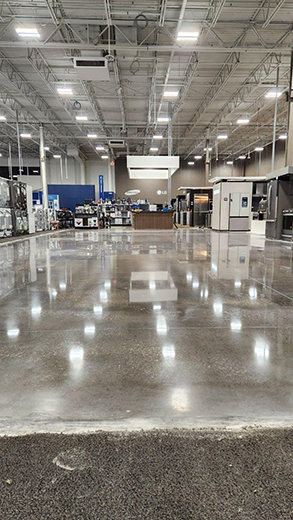Does your commercial building have concrete floors? Are you finding it difficult to maintain the floor’s condition?
Facility managers sometimes struggle with keeping concrete floors in good condition, particularly in warehouses and other high-traffic areas.
Though they may not seem like it, concrete floors need regular maintenance and cleaning. By implementing an annual concrete floor maintenance plan, you can actively monitor and record any problems with your floors and have them serviced to keep them in good condition.
Companies like ACT Restoration provide deep polishing and resurfacing services for concrete floors, perform floor prep, and apply stains and dyes. Professionals have the right equipment and experience to make quick work of your concrete floors, ensuring they are perfect and safe for your commercial building.
Below, ACT Restoration explains how to create an annual concrete floor maintenance plan for your commercial building.
Assess Floor Condition
Before you set up a regular maintenance schedule for your concrete floors, you need to perform a thorough floor inspection. There are plenty of signs your concrete floor needs repairs. Inspect for damage to the floor, including cracks, chips, stains, and surface wear.
You should also keep an eye out for hazards like spalling, pitting, and uneven surfaces.
Once you have a good idea of the floor’s current state, you can identify the high-traffic areas that may need more frequent maintenance and attention. That information will help you plan a regular maintenance schedule.
Develop Cleaning Schedule
Concrete floors need regular cleaning to keep them in good condition. It’s important to develop a daily, weekly, and monthly cleaning schedule in addition to an annual deep cleaning.
A sample schedule looks like this:
- Daily Cleaning:
- Sweep or vacuum debris to prevent scratches.
- Damp mop with a pH-neutral cleaner.
- Weekly Cleaning:
- Use auto-scrubbers in large spaces for deeper cleaning.
- Address stains immediately to prevent penetration.
- Monthly Polishing:
- Buff or burnish the floor to maintain gloss and surface integrity.
- Annual Deep Cleaning:
- Schedule professional cleaning to remove embedded dirt and reseal if necessary.

Polished concrete flooring at a Best Buy in Minnesota.
Plan for Repairs
After your inspection, it’s time to plan repairs for your concrete floor. For small cracks and chips, you can use epoxy or polyurethane fillers. Larger cracks should be handled by a professional to ensure it is properly filled and leveled.
For surface imperfections, you can schedule a grind and polish appointment with a concrete floor restoration company, which will smooth uneven areas or rough patches.
The joints in your concrete floor need attention as well. Concrete floor joints are deliberately placed lines or cuts in the concrete, which helps prevent cracks due to shrinkage and helps the floor handle temperature changes.
Regularly inspect control joints for damage and refill with joint sealant if needed. This specific type of sealant helps prevent the cracks from filling with dirt and grime, and reduces spalling around the joints.
Reapply Sealers & Coatings
Concrete floors need to be sealed annually to protect it from damage and wear. Professional concrete floor technicians can use high-quality sealers to protect your floor against moisture, stains, and abrasions.
If you have polished concrete, you can add densifiers to harden the surface and maintain the shine. The best ways to maintain polished concrete floors are to clean them daily with a dust mop and wipe up spills immediately.
Concrete floors can be sealed with epoxy or urethane coatings as well. These work well in high-traffic areas or chemically exposed areas. It provides a nice barrier and comes in many colors.
Schedule Preventative Maintenance
Every facility should perform preventative maintenance to keep everything running smoothly. Just like your HVAC system needs preventative maintenance, your concrete floors need it too.
Some methods of concrete floor preventative maintenance include:
- Serving floor equipment regularly to keep them in good condition
- Maintain humidity levels to prevent cracking or moisture damage
- Create a checklist for quarterly inspections, which can help catch issues early
Track Maintenance Records
Always keep track of your maintenance records and activities. There are plenty of databases designed to help maintain this information, or a simple spreadsheet would work as well. Document all cleaning schedules, repairs, and inspections.
You can also maintain records to track wear patterns and plan for future budgets.
Hire Professional Concrete Floor Services Near the Twin Cities
Professional concrete restoration companies can help you maintain your concrete floor. Choosing ACT Restoration for concrete floor services in Andover, Minnesota, provides decades of experience working with concrete floors.
We use a unique wet grind method for floor prep, which helps reduce dust in the air and aid in cleanup.
Our technicians always provide exceptional customer service and workmanship. We can also handle terrazzo floors and natural stone.
Call us today at 763-432-3966 or request a free estimate online!